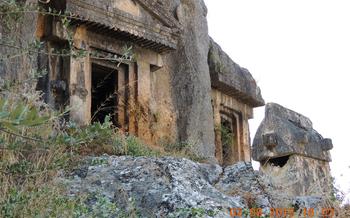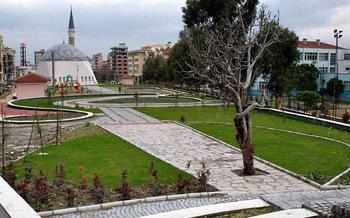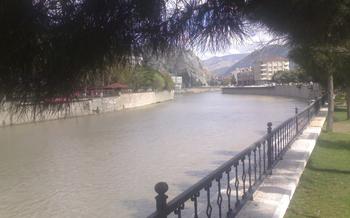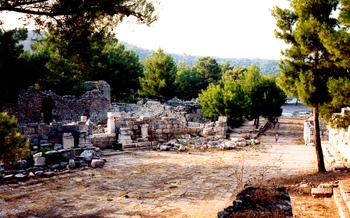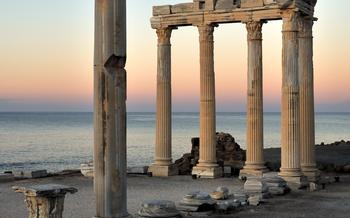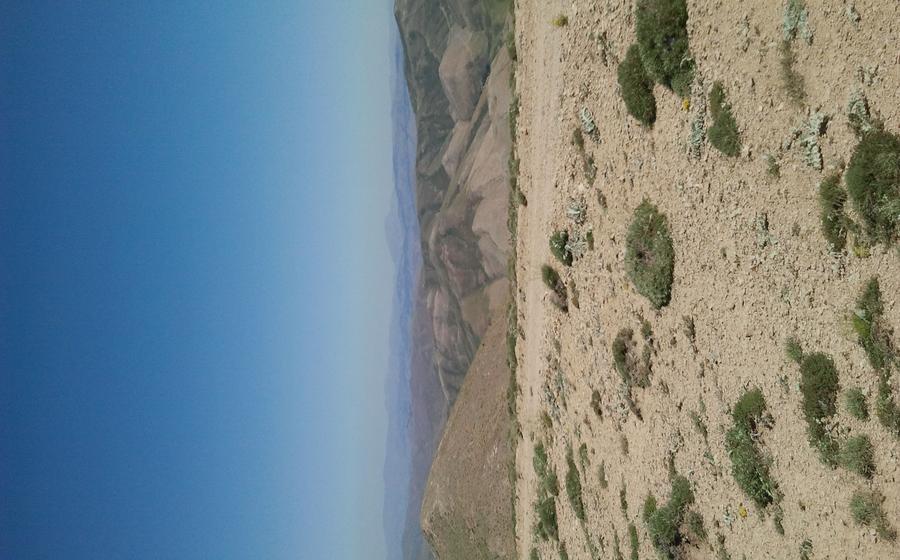
Yakınca Rock Tombs and Monuments
- Yakınca Rock Tombs: A Historical Marvel
- Exploring the Necropolis
- The Hellenistic and Roman Influence
- The Role of the Dead in Society
- Comparison with Other Rock Tombs
- Visiting the Yakınca Rock Tombs
- The Village of Yakınca
- Other Nearby Attractions
- The Art of the Rock Tombs
- Preservation and Conservation
- Local Cuisine and Delicacies
- The Role of Technology
- Impact on Local Tourism
- Archaeological Research and Discoveries
- Insider Tip: Hidden Gem
Yakınca Rock Tombs: A Historical Marvel
The Yakınca Rock Tombs, located in the Malatya province of Turkey, stand as a testament to the rich history and cultural heritage of the region. Carved into the rocky cliffs overlooking the town of Yakınca, these tombs date back to the Hellenistic and Roman periods, offering a glimpse into the lives and beliefs of ancient civilizations.
The tombs, with their intricate carvings and motifs, are a testament to the skill and artistry of their creators. Symbolizing religious beliefs and cultural practices, the tombs provide valuable insights into the lives and rituals of the ancient people who inhabited this region. The Yakınca Rock Tombs are a reminder of the enduring legacy of ancient civilizations and the importance of preserving and protecting cultural heritage for future generations.
Exploring the Necropolis
The Yakınca Rock Tombs form an extensive necropolis, a city of the dead, that offers a glimpse into the funerary practices and beliefs of ancient civilizations. The tombs are arranged in a series of terraces, with the largest and most elaborate tombs located at the highest level. Each tomb varies in size and complexity, ranging from simple chambers to elaborate structures with multiple rooms and intricate carvings.
The tombs were designed to accommodate a variety of burial practices. Some tombs contain single burials, while others were used for multiple interments. The deceased were often buried with grave goods, such as jewelry, pottery, and weapons, which provide valuable insights into their social status and cultural beliefs.
Archaeological excavations at the site have uncovered a wealth of artifacts and information about the necropolis. These excavations have revealed evidence of different burial customs and rituals, as well as the evolution of tomb architecture over time. The discoveries made at Yakınca have contributed significantly to our understanding of ancient Anatolian funerary practices and beliefs.
The Hellenistic and Roman Influence
The Yakınca Rock Tombs bear witness to the profound influence of Greek and Roman culture on the region. Architectural styles and motifs from the Hellenistic and Roman periods are evident in the tombs, reflecting the cultural exchange and assimilation that occurred during this time. Greek and Roman artistic traditions, such as the use of columns, pediments, and decorative elements, are integrated with local Anatolian elements, creating a unique blend of styles. The tombs also feature inscriptions and carvings that mention Greek and Roman deities, indicating the integration of local religious beliefs with those of the dominant powers. These influences are a testament to the cultural diversity and cosmopolitan nature of the region during the Hellenistic and Roman periods.
The Role of the Dead in Society
In ancient Malatya, the dead held a significant place in society. Their beliefs about the afterlife were deeply rooted in the idea of a continued existence after death. The tombs were not merely burial chambers but were also considered as houses for the deceased, where they could continue their journey in the afterlife.
The Yakınca Rock Tombs provide evidence of the elaborate rituals and practices associated with death and burial. The tombs were adorned with intricate carvings and motifs, which served as both decoration and symbols of the deceased's life and accomplishments. Offerings were placed within the tombs to provide the deceased with provisions for their journey into the afterlife.
The veneration of the dead was an important part of ancient Malatyan society. Commemorative ceremonies and rituals were held to honor the deceased and to ensure their continued well-being in the afterlife. These rituals helped to maintain the connection between the living and the dead, and to provide a sense of comfort and closure to the bereaved.
The Yakınca Rock Tombs offer a glimpse into the complex and fascinating beliefs and practices surrounding death and the afterlife in ancient Malatya. They provide valuable insights into the social and cultural significance of death in this ancient society, and how it shaped the lives of the living.
Comparison with Other Rock Tombs
The Yakınca Rock Tombs share similarities with other rock-cut tombs found throughout Anatolia, yet they also possess unique features that set them apart. Similarities include the use of carved chambers and niches for burials, as well as the presence of intricate carvings and motifs. However, the Yakınca tombs stand out due to their exceptional size and the variety of tomb types found within the necropolis.
Another unique aspect of the Yakınca tombs is their integration of local traditions with Hellenistic and Roman influences. This is evident in the architectural styles and motifs, which combine elements from both cultures. For example, the tombs feature both Greek pediments and Roman arches, demonstrating the cultural exchange and assimilation that occurred during this period.
In terms of regional variations, the Yakınca tombs exhibit similarities with other rock-cut tombs found in the Malatya region. However, they also display distinct characteristics that reflect local preferences and traditions. For instance, the Yakınca tombs tend to be larger and more elaborate than other tombs in the area, suggesting the importance placed on funerary practices and the commemoration of the dead in this particular community.
These regional variations highlight the cultural diversity and artistic expression that existed throughout Anatolia during the Hellenistic and Roman periods. The Yakınca Rock Tombs, with their unique features and influences, offer a valuable glimpse into the rich cultural heritage of this region.
Visiting the Yakınca Rock Tombs
Location and accessibility:
The Yakınca Rock Tombs are located in the village of Yakınca, in the Malatya province of Turkey. To reach the tombs, visitors can take a bus or drive from Malatya city, which is about 40 kilometers away. The tombs are situated on a hillside overlooking the village, and visitors can easily walk to the site from the village center.
Best time to visit:
The best time to visit the Yakınca Rock Tombs is during the spring or autumn months, when the weather is pleasant and mild. The summer months can be hot and dry, while the winter months can be cold and snowy.
Guided tours and self-exploration:
Guided tours of the Yakınca Rock Tombs are available, which can provide visitors with insights into the history, architecture, and significance of the tombs. Visitors can also choose to explore the site on their own, as there are information boards and signage to help them understand the different features of the tombs.
Facilities and amenities for visitors:
The Yakınca Rock Tombs are a popular tourist destination, and there are a number of facilities and amenities available for visitors. These include a visitor center, restrooms, and a small café where visitors can purchase snacks and refreshments.
The Village of Yakınca
The village of Yakınca, nestled amidst the enchanting landscapes of Malatya, has a rich history that intertwines with the ancient rock tombs. Inhabited since ancient times, the village carries the legacy of the people who once built and utilized these remarkable structures. The villagers have a deep connection with the tombs, treating them with reverence and preserving their stories and traditions.
Yakınca's inhabitants are known for their warm hospitality, welcoming visitors with open arms. They are eager to share their knowledge of the tombs and the village's history, providing insights into the lives of their ancestors. The village's traditional lifestyle and customs offer a glimpse into the past, creating a unique and authentic experience for visitors.
The village's proximity to the tombs makes it an ideal base for exploration. Visitors can wander through the village's cobblestone streets, admiring the traditional architecture and vibrant local life. The village also offers a range of accommodation options, from charming guesthouses to homestays, allowing visitors to immerse themselves in the local culture.
Yakınca's scenic surroundings invite visitors to explore the natural beauty of the region. The village is surrounded by rolling hills, lush valleys, and picturesque landscapes, perfect for hiking, cycling, and nature walks. Visitors can also enjoy the tranquility of the nearby Yakınca River, a serene spot for relaxation and contemplation.
Other Nearby Attractions
Beyond the Yakınca Rock Tombs, the region offers a wealth of other attractions that complement a visit to the ancient necropolis. History enthusiasts can delve into the past at the nearby Malatya Museum, which houses a rich collection of artifacts from the region's rich past. Nature lovers can escape to the stunning natural beauty of the nearby Taurus Mountains, where hiking trails lead to breathtaking views and hidden waterfalls.
For those seeking a cultural immersion, the vibrant city of Malatya offers a glimpse into modern Turkish life. Visitors can explore the bustling markets, savor the flavors of traditional cuisine, and experience the warmth and hospitality of the local people. Malatya is also home to several historical landmarks, including the majestic Malatya Castle and the impressive Ulu Mosque, which showcase the region's architectural heritage.
Combining a visit to the Yakınca Rock Tombs with other nearby attractions creates a well-rounded and enriching travel experience. Whether seeking historical insights, natural wonders, or cultural encounters, visitors to this region are sure to find a diverse range of attractions that cater to their interests.
The Art of the Rock Tombs
The Yakınca Rock Tombs are not just historical monuments but also masterpieces of ancient art. The tombs are adorned with intricate carvings, sculptures, and motifs that showcase the skill and artistry of the ancient craftsmen. The carvings depict various subjects, including mythological scenes, religious symbols, and everyday life events. The tombs also feature impressive architectural elements such as columns, arches, and pediments, which demonstrate the advanced architectural skills of the builders.
The symbolism and iconography used in the carvings provide valuable insights into the beliefs and rituals of the ancient people. For example, the frequent depiction of the bull suggests its significance as a sacred animal, while the presence of fertility symbols indicates the importance of agricultural practices in the region. The tombs also feature representations of gods and goddesses, providing a glimpse into the religious beliefs of the time.
The craftsmanship and skill of the artisans who created these tombs are evident in the intricate details and precision of the carvings. The tombs were carved directly into the rock, requiring great skill and patience. The artists used a variety of techniques, including chiseling, hammering, and polishing, to create the intricate designs and figures. The resulting artworks are a testament to the artistic talent and dedication of the ancient craftsmen.
The artistic legacy of the Yakınca Rock Tombs has influenced subsequent artistic traditions in the region. The motifs and styles used in the tombs can be seen in later Anatolian art and architecture, demonstrating the enduring impact of this ancient artistic tradition.
Preservation and Conservation
The Yakınca Rock Tombs, as a significant cultural heritage site, require careful preservation and conservation efforts to ensure their longevity. The local authorities, in collaboration with conservation experts, have implemented various measures to protect these ancient tombs from deterioration and damage. Regular maintenance and restoration work are carried out to address issues such as erosion, weathering, and structural instability.
One of the challenges in conserving the tombs is their exposure to natural elements, particularly the harsh climate conditions of the region. Temperature fluctuations, strong winds, and occasional seismic activity can contribute to the degradation of the rock carvings and architectural features. To mitigate these effects, protective measures such as scaffolding, weatherproofing treatments, and controlled access to the site are implemented.
Another important aspect of conservation involves the management of tourism and visitation. While tourism plays a vital role in promoting the tombs and generating revenue for conservation efforts, it also brings potential risks, such as increased foot traffic, vandalism, and wear and tear. To strike a balance between accessibility and preservation, visitor numbers are carefully monitored, and guided tours are conducted to ensure responsible and respectful exploration.
Furthermore, the use of innovative technologies, such as 3D scanning and modeling, contributes to the preservation and documentation of the tombs. These technologies allow for the creation of detailed digital replicas that can be used for research, conservation planning, and virtual tours. By employing cutting-edge techniques, experts can study and preserve the tombs without causing any physical damage.
By implementing comprehensive conservation strategies, raising awareness among visitors and locals, and promoting sustainable tourism practices, the Yakınca Rock Tombs can continue to stand as a testament to the rich cultural heritage of the region for generations to come.
Local Cuisine and Delicacies
Malatya is renowned for its culinary delights, offering a diverse range of traditional dishes and specialties that reflect the region's rich cultural heritage. Visitors can indulge in mouthwatering kebabs, savory stews, and freshly baked pastries, all bursting with unique flavors and aromas.
One must-try dish is the "Malatya Köftesi," a specialty kebab made from minced lamb seasoned with local spices and grilled to perfection. The "Malatya Kayısısı," a sweet and succulent apricot, is another culinary treasure, famous for its distinct flavor and nutritional benefits.
For a taste of traditional bread, visitors can savor the "Malatya Ekmeği," a flatbread known for its crispy crust and soft, chewy interior. Local restaurants and markets offer a variety of fresh and seasonal produce, allowing visitors to experience the authentic flavors of Malatya's cuisine.
Whether it's a leisurely meal at a local restaurant or a stroll through the vibrant markets, exploring the culinary delights of Malatya is a feast for the senses and a true immersion into the region's rich cultural heritage.
The Role of Technology
Technology has played a crucial role in studying and preserving the Yakınca Rock Tombs. Three-dimensional (3D) scanning and modeling techniques have been employed to create detailed digital representations of the tombs, providing researchers with a valuable tool for analysis and documentation. These 3D models allow experts to examine the tombs' intricate carvings and motifs from various angles, facilitating a deeper understanding of their symbolism and artistic significance.
Virtual reality (VR) and immersive experiences have also been utilized to bring the Yakınca Rock Tombs to life. These technologies enable visitors to virtually explore the tombs, immersing themselves in their historical context and experiencing the grandeur of these ancient monuments from a unique perspective. VR tours offer an interactive and engaging way to learn about the tombs' history, architecture, and cultural significance.
Furthermore, technology has aided in the preservation and promotion of the Yakınca Rock Tombs. High-resolution images and videos captured using drones and specialized cameras provide valuable documentation for conservation efforts. These visual records help identify areas requiring restoration or protection, enabling timely interventions to safeguard these precious cultural heritage sites.
By harnessing the power of technology, researchers, conservators, and cultural heritage enthusiasts can effectively study, preserve, and promote the Yakınca Rock Tombs for future generations.
Impact on Local Tourism
The Yakınca Rock Tombs have played a significant role in boosting tourism in the Malatya region. With their unique historical and cultural value, the tombs have attracted visitors from around the world, eager to explore this ancient necropolis. The influx of tourists has had a positive economic impact on the local community. It has created job opportunities in the tourism sector, including tour guides, transportation providers, and hospitality workers. Additionally, the increased tourism has led to the development of local businesses, such as souvenir shops, restaurants, and cafes, catering to the needs of visitors. The promotion of cultural heritage and tourism has also contributed to the preservation and conservation of the Yakınca Rock Tombs, ensuring their legacy for future generations. However, managing tourism effectively presents challenges, such as ensuring responsible and sustainable practices to protect the tombs from potential damage while accommodating the growing number of visitors.
Archaeological Research and Discoveries
The Yakınca Rock Tombs have been a subject of extensive archaeological research and excavation over the years. Teams of archaeologists have meticulously studied the site, uncovering valuable insights into the lives and beliefs of the ancient inhabitants. Through careful excavation techniques, they have unearthed a wealth of artifacts, including pottery, jewelry, and coins, which provide clues about the cultural practices and economic activities of the time.
Recent excavations have shed new light on the chronology and construction of the tombs. Researchers have identified different phases of construction, revealing that the site was in use for several centuries. The discovery of inscriptions and funerary objects has helped to identify the individuals buried in the tombs, providing valuable information about their social status and family relationships.
The ongoing research at the Yakınca Rock Tombs is contributing significantly to our understanding of ancient Anatolian cultures. By piecing together the evidence from artifacts, architecture, and inscriptions, archaeologists are gaining a deeper insight into the religious beliefs, burial practices, and daily lives of the people who once inhabited this region.
Insider Tip: Hidden Gem
While the Yakınca Rock Tombs are undoubtedly awe-inspiring, there's another hidden gem that deserves your attention. Just a short distance away, nestled amidst rolling hills and olive groves, lie the lesser-known Karakaya Rock Tombs. These tombs, though smaller in size, are equally impressive in their intricate carvings and unique architectural features. The Karakaya tombs offer a more intimate and secluded experience, allowing you to appreciate the artistry and craftsmanship up close.
Off-the-beaten-path experiences like these are a true delight for travelers seeking hidden treasures. Remember to approach these sites with respect and responsibility, minimizing your impact on the environment and the local community. Embrace the opportunity to delve deeper into the region's rich cultural heritage and discover the beauty that lies beyond the well-trodden tourist trails.


